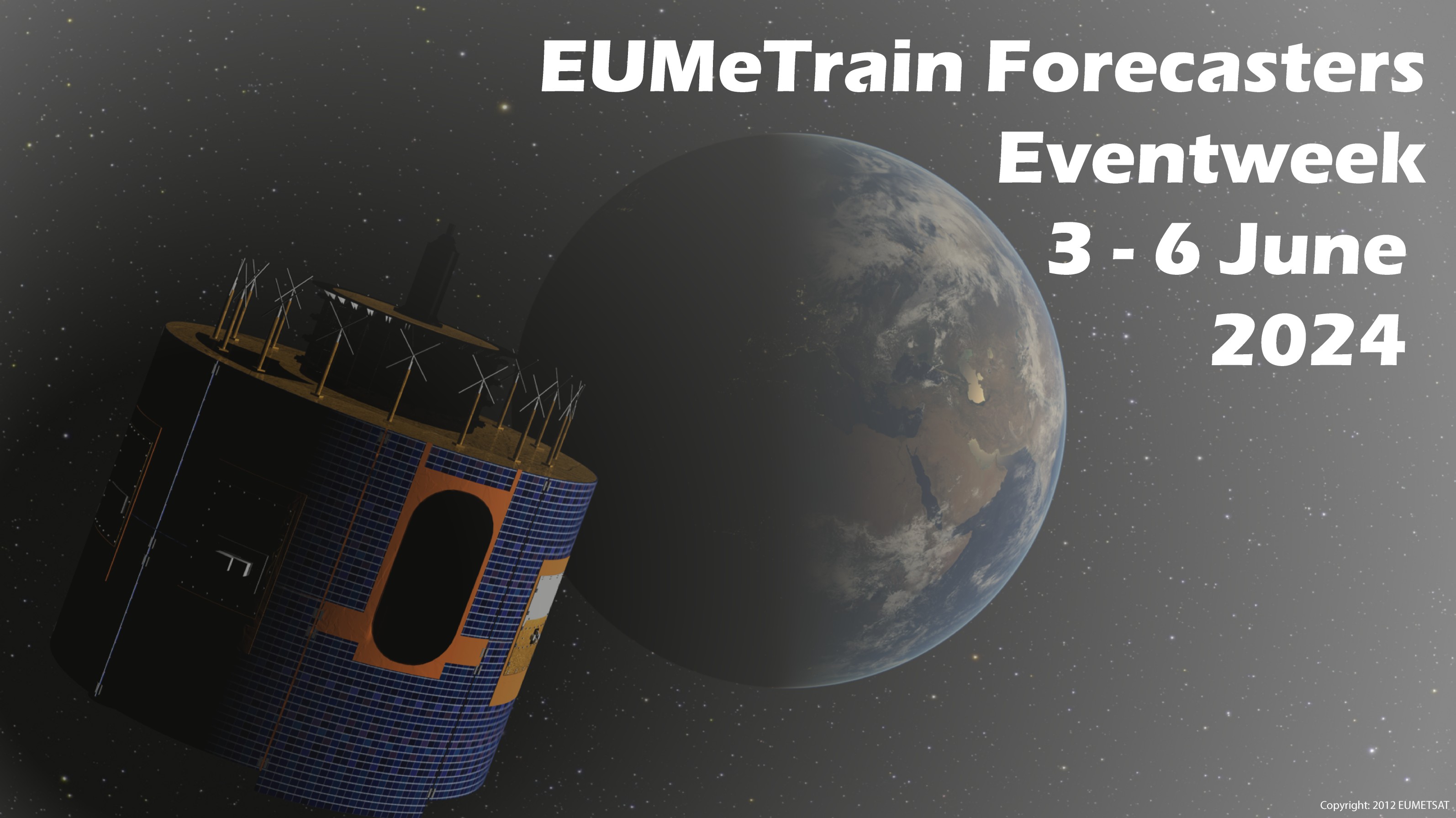Forecaster's Event Week 2024

In the week from 3 to 6 June 2024 EUMeTrain organized the Forecaster's Event Week. During the event week there were 9 presentations and a workshop which covered forecast related topics such as aviation forecasting challenges, forecasting and nowcasting of convection, severe weather case studies, dust infused baroclinic storms, sat-products and work structure in different met services, RGB imagery and more.
Session 1 - 3 June 2024
Jorge Ponte (IPMA) - Extreme Rainfall Case Study Lisbon 2022
Extreme rainfall events in December 2022 caused significant losses in Lisbon, Portugal. This presentation examines these events to discuss whether it was possible (or not) to make a better forecast and issue earlier warnings. By analyzing various numerical model products from the preceding days alongside real-time monitoring data (satellite, radar, stations), the presentation will explore the operational forecaster's decision-making process during extreme weather situations.
Session 2 - 4 June 2024
Celia Gouveia (IPMA) - Monitoring wildfires
LSA-SAF generates a large set of products for land surface characterization derived from SEVIRI on board Meteosat Second Generation (MSG). The availability of such datasets in Near Real Time (NRT) allows a continuous monitoring of the situation before, during and after wildfire. The monitoring of the situation during the fire season relies on the fire risk mask (FRM) disseminated daily and with 5 days in advance. The severity of the occurred events is assessed by means of Fire Radiative Power. Post fire conditions over burned areas and the assessment of the impact of fire events on vegetation regeneration is assessed by means vegetation products.
Marco Stoll (MeteoSwiss) - Challenges in aviation weather forecasting: the example of mountain waves
Meteorological information is crucial for flight safety and efficiency. Mountain waves are an example of a potentially hazardous phenomenon for aviation that meteorological watch offices need to monitor and forecast. The typical appearance of the phenomenon in satellite imagery is illustrated, thereby making use of various MSG channels and RGB products. The difficult task of quantifying vertical speeds and estimating the degree of turbulence associated with breaking waves is discussed with the aid of NWP cross sections.
Katarina Katušić (DHMZ) - Sat-Products in the Prognostic service of DHMZ
The Weather and Marine Analysis and Forecasting Sector is a part of the Croatian Meteorological and Hydrological Service (DHMZ), and it is in charge of weather forecasts and warnings for the public and numerous companies. Over the years, we have gone through many challenges. Quite recently, during the lockdown, the earthquake severely damaged our headquarters, and even with those difficulties the work did not stop. Currently, we are tenants in the sweets factory and our working days are spiced with the smell of chocolate. We also prepare and present weather forecasts for national television. Furthermore, this presentation will cover the usage of weather satellite products in daily operational work.
Session 3 - 5 June 2024
Liliane Hofer (GSA) - Specialties of forecasting weather in Austria
Various phenomena, some of which are regionally specific, such as southerly föhn winds or precipitation in northern or southern congestion, make the weather forecast in Austria very challenging at times. In addition, the topographically highly structured landscape also results in quite small-scale differences, for example in inversion weather conditions. All this and special customer products are highlighted in this presentation, as well as the basic working environment of the forecasters and, of course, the satellite products used for this purpose.
Georg Pistotnik (GSA) - The identification of drylines and their relevance for thunderstorms
Drylines are boundaries separating warmer and drier from cooler and moister air, usually resulting from differential diurnal heating and therefore vertical mixing. The most common and distinct dryline in the Alpine region is the boundary between Foehn winds (dynamically driven) and upvalley/upslope circulations (thermally driven). Thunderstorms often form along drylines and intensify when they move onto their moist side, where CAPE and vertical wind shear are systematically enhanced and favor convective organization. This presentation highlights how station and readiosonde data, high-resolution satellite imagery and even webcam images can be integrated into the nowcasting of drylines and resulting thunderstorms, using some prominent cases of the past few years in the eastern Alpine region.
Andreas Wirth (GSA) - Dust Infused Baroclinic Storms (DIBS)
Dust Infused Baroclinic Storms (DIBS) have a high impact on weather. Mineral dust particles in the atmosphere reduce sunlight at lower levels, reduce visibility and damp daily temperature maxima. Dust particles can have an impact on forecasted precipitation too, and in higher concentrations, dust particles can cause respiratory problems.
This presentation focuses on circulation pattern that causes dust transport towards Europe and on how to detect high dust loads in- and outside clouds from geostationary satellite imagery on the basis of recent examples.
Session 4 - 6 June 2024
Vinko Šoljan (Crocontrol) - Forecasting and Nowcasting of deep moist convection
In this presentation, we will demonstrate the process of forecasting deep moist convection (DMC) at Croatia Control and how satellite products are utilized in this process. This includes large-scale analysis and diagnosis using satellite data, as well as monitoring and nowcasting existing DMC using satellite products and radar data. In DMC forecast we primarily rely on the ingredients-based methodology and NWP guidance.
Zsofia Kocsis (HungaroMet) - Introduction to RGBs
In this talk we will cover what are the benefits of working with RGBs compared to single channels satellite data. We will cover how we can create RGBs, what makes an RGB good and we will also talk about what are the standard RGBs and why we like to use them.
